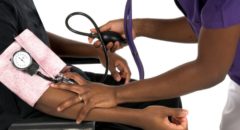
Chronically high levels of stress may increase Black Americans' risk of high blood pressure, a new study suggests.
"Given the disproportionately high burden of hypertension in African-Americans, determining if chronic stress increases the risk of hypertension in this population is an important question that could guide prevention strategies," said lead study author Tanya Spruill, an associate professor at NYU School of Medicine.
For the study, researchers analyzed data from more than 1,800 black participants in the Jackson Heart Study. They found that over seven years, those who reported long-term high stress levels were 22% more likely to develop high blood pressure than those with low stress levels.
High blood pressure can contribute to stroke, a leading cause of death and disability.
The link between stress and blood pressure was independent of sociodemographic factors, traditional high blood pressure risk factors, and health behaviors.
The results were published on October 16, 2019, in the Journal of the American Heart Association.
"Over the study follow-up period, almost half of the participants developed hypertension," Spruill said in a journal news release. "This highlights the need for new hypertension prevention strategies for African-Americans. Lifestyle change is effective, however, it can be challenging to achieve."
Spruill said that culturally sensitive stress management interventions may help prevent high blood pressure and reduce subsequent heart risk among Black Americans. But more research is needed first.
"Because this is an observational study, we interpret the findings cautiously. However, our results suggest that evaluating chronic stress over time rather than at a single occasion can help identify those at greatest risk," she said.
Blacks report higher overall stress levels than whites, the authors noted.
For more information on Black Americans and high blood pressure, visit The American Heart Association.
SOURCE: Journal of the American Heart Association, news release, Oct. 16, 2019
3 Ways To Tackle Hypertension, Starting Now!
 There is a strong possibility that each of us knows someone with hypertension or, perhaps, you may have it yourself. Hypertension, which occurs when the blood pressure in the arteries is elevated, is also commonly known as high blood pressure. With the recent recall of several drugs that treat hypertension, many African Americans found themselves scrambling to their medicine cabinets to take a closer look at what was inside.
There is a strong possibility that each of us knows someone with hypertension or, perhaps, you may have it yourself. Hypertension, which occurs when the blood pressure in the arteries is elevated, is also commonly known as high blood pressure. With the recent recall of several drugs that treat hypertension, many African Americans found themselves scrambling to their medicine cabinets to take a closer look at what was inside.
This vast recall also served as a lynchpin moment for understanding how pervasive hypertension is within Black communities. Disproportionately affected, Black people have a higher propensity for being diagnosed with hypertension.
According to research conducted by the American Heart Association, “The prevalence of high blood pressure (HBP or hypertension) in African-Americans in the United States is among the highest in the world.
More than 40 percent of non-Hispanic African-American men and women have high blood pressure. For African-Americans, high blood pressure also develops earlier in life and is usually more severe.”
Because blood pressure is connected to other bodily functions and the overall health of all major organs, if left undiagnosed or untreated, it can be a precursor for strokes, kidney disease, andcoronary disease. If you compound this with other co-morbidities, such as diabetes, then it becomes crystal clear as to why hypertension is also referred to as the silent killer.
The good news is that there are measures that we all can take, starting right now, that can help prevent, offset, or even better manage hypertension. Although there is no ‘one size fits all’ and it is highly recommended that you consult with your physician before beginning any new regimen, here are a few things that you might want to consider:
Your Diet
There is an old adage that “you are what you eat.” This rings especially true as it relates to hypertension. Diets that are high in salt can exasperate your blood pressure. Historically, diets in the Black community have relied upon some food staples that tend to be on the saltier side.
This, in part, maybe because of the prevalence of salt in the preservation methods that were used generations ago to preserve meat, especially in rural and agrarian communities. At one point, salt was necessary for long term storage purposes and to prevent certain meats from rotting. So, when we think of cuisines that are sometimes referred to as soul food, images of salty foods may emerge.
However, with advances in preservation methods and dietary research, we now know that adding too much salt or additional salt can be dangerous. Even though that large bag of chips may be tempting, or adding salt to your food before you taste it may be a long-held habit, give some consideration to lightly salted or unsalted snacks. And rather than assume that your meal needs a sprinkle of salt, try it first and then season to taste.
Lastly, when preparing your food or even buying food products, read the labels. Salt, or sodium, may be buried somewhere on the list, but be sure to look for it. Try using products like Ms. Dash that do not include salt amongst its list of ingredients. Contrary to what some may believe, you do not have to compromise taste when switching to a low sodium diet.
Because obesity is a leading factor in hypertension, we can’t ignore the proverbial elephant in the room: One’s dietary habits and exercise often go hand-in-hand.
Let’s Exercise
Everywhere we look, there tends to be an advertisement for a gym, workout equipment, or the newest fad or trend. Some of these may have monthly fees attached to them or they may be expensive; yet, there is a form of exercise that most of us can engage in that has amazing benefits and that’s walking. Yes, walking.
Although gym memberships are advantageous as are personal trainers and strength conditioning, walking can be a great first step for integrating exercise into your daily routine.
Think about the last time that you went to a mall or an entertainment complex. Where did you park? How much time did you circle the parking lot looking for the ideal space—close to the building? Something as simple as parking further away from the door or taking the stairs, instead of the elevator, can increase your heart rate and your overall blood circulation, which helps with hypertension.
If you have access to a park or a trail, consider adding 20 to 30 minutes of walking to your day. Too cold to walk outside? Try walking around your home. A great technique that will also help you integrate walking into your routine is walking in place during commercial breaks. Or, you may want to invest in a treadmill at home. If walking is not rigorous enough for you, look into other methods of exercising including circuit training, running and/or jogging.
Lifestyle Choices
Lifestyle choices at home and at work can also help you address hypertension. One of the most immediate things that you can do is invest in a high-quality blood pressure monitor that you can use at home. Because these vary by manufacturer and sometimes the readings are slightly off, ask your doctor if you canbring your home monitor to your next appointment with you.
He/she can check the reading on your device and compare it to their reading to see if your machine is accurate and within range. Being able to monitor your blood pressure at home is critical to your well-being and it allows you to stay informed.
During your leisure time, instead of meeting friends for dinner and a movie, take a cooking class or host one at your home. If cooking is not in your wheelhouse, see if one of the local community colleges offers culinary classes for the public. Also, think about your alcoholic drinking habits—do you really need that second shot of tequila in your strawberry margarita? Surprisingly, drinking alcohol, like smoking, can contribute to hypertension, so consume in moderation, if at all.
Home is not the only place where we need to think about how our actions affect our health. With many of us now working from desks and sitting in front of computer screens for extended periods of time, Americans now have a more sedentary lifestyle. If you can, try standing up or even asking your employer to secure a standing desk for you. Use your lunch hour and breaks to get some exercise. If you travel for work, be sure to get up, as permitted, while traveling.
You are not Alone
Trying to tackle hypertension alone may be difficult, so if you need accountability, seek the help of your friends. Check with your network to see if anyone is a registered dietitian or a health advocate. Some hospitals will even offer support groups or community health classes and events. There are even many amazing health-themed virtual communities for those who prefer to go the social media route.
Whatever decision you make about tackling hypertension, the key is to be informed and to take action. In some instances, a person may have a predisposition to hypertension due to one’s family history. Medications such as diuretics and beta-blockers may be the best course of action as determined by a medical doctor. Yet, even with prescribed medication, it is important that you still learn as much as you can about hypertension and how it affects your body.
Hypertension does not have to be a silent killer. The more we know, the more we can address it and its residual effects. You may not be ready to run a marathon, but every step you take towards making a commitment to your health is a step towards a better version of you.









